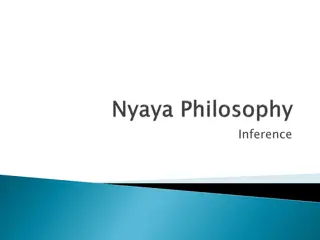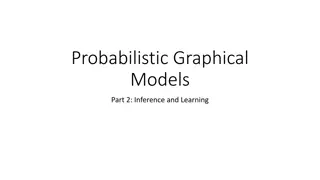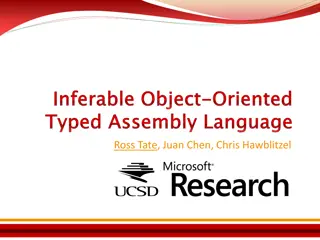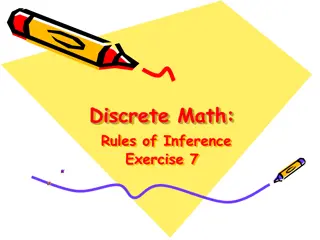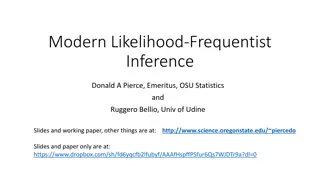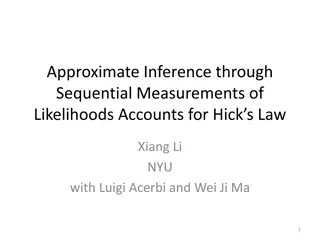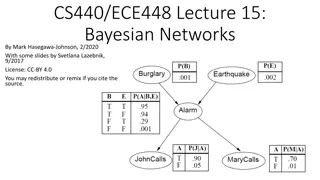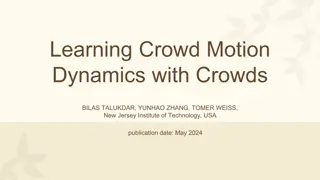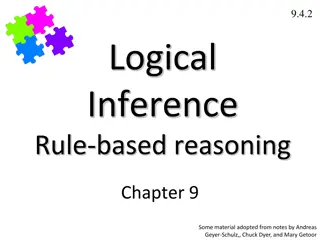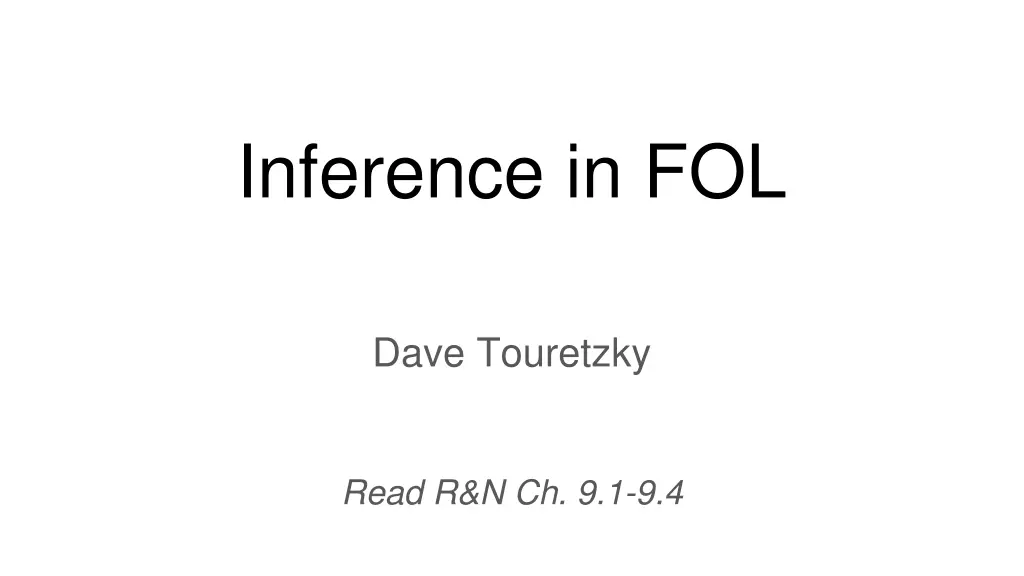
Automated Inference in First-Order Logic: Techniques and Applications
Learn how to perform automated inference in First-Order Logic through reduction to propositional inference, Horn theories, resolution theorem proving, variable substitution, and lifted inference algorithms.
Download Presentation

Please find below an Image/Link to download the presentation.
The content on the website is provided AS IS for your information and personal use only. It may not be sold, licensed, or shared on other websites without obtaining consent from the author. If you encounter any issues during the download, it is possible that the publisher has removed the file from their server.
You are allowed to download the files provided on this website for personal or commercial use, subject to the condition that they are used lawfully. All files are the property of their respective owners.
The content on the website is provided AS IS for your information and personal use only. It may not be sold, licensed, or shared on other websites without obtaining consent from the author.
E N D
Presentation Transcript
Inference in FOL Dave Touretzky Read R&N Ch. 9.1-9.4
Review: How to do automated inference in FOL 1. Reduction to propositional inference previous lecture - Models are potentially infinite - But any true sentence can be proved in a finite model 1. Horn theories: a. Forward chaining b. Backward chaining This lecture 2. Resolution theorem proving next lecture 2
Review: propositional Modus Ponens , ----------------- Here, and can be any propositional formula. What happens when we add variables? 3
Variable substitution drives inference in FOL Given a sentence Man(x) Mortal(x) and another sentence Man(socrates) Apply the substitution = { x / socrates } to derive Man(socrates) Mortal(socrates) Then we can apply Modus Ponens to conclude 4 Mortal(socrates)
Generalized Modus Ponens Let pi, pi , be atomic sentences where there is a substitution such that SUBST( ,pi ) = SUBST( ,pi) for 1 i n. Let q also be an atomic sentence. Then the Generalized Modus Ponens inference rule is: p1 , p2 , , pn , p1 p2 pn q --------------------------------------------------------- SUBST( ,q) This is a lifted (more abstract) version of Modus Ponens, allowing us to move beyond ground (variable-free) statements. Why the restriction to atomic sentences? 5
Lifted inference algorithms We can develop lifted versions of: Forward chaining Backward chaining Resolution theorem proving More efficient than universal instantiation: can focus on just the sentences relevant to our inference rules. But where does the substitution come from? 6
Unification Given two sentences p and q, a unifier of p and q is a substitution such that SUBST( ,p) = SUBST( ,q) Knows(john, x) Knows(john, jane) = { x / jane } Knows(john, x) Knows(y, bill) john } = { x / bill, y / Knows(john, x) Knows(y, mother(y)) mother(john) } = { y / john, x / Knows(john, x) Knows(x, elizabeth) knows Liz fail even though everyone 7 Standardizing apart:
Most general unifier What are the legal unifiers of Knows(john, x) Knows(y, z) = { x / john, y / john, z / john } gives Knows(john, john) = { y / john, x / z} MGU gives Knows(john, z) Every pair of sentences has a MGU that is unique up to variable renaming. The MGU is what we want to use for inference. 8
Occurs check A variable cannot unify with a formula that contains that variable. For example: f(x) cannot unify with f(f(x)) = { x / f(x) } Occurs checks make unification quadratic in the length of the expression. Some inference systems skip them, for efficiency s sake. 9
Unifying a variable with something function UNIFY-VAR(var, x, ) returns a substitution if { var / val } then return UNIFY(val, x, ) else if { x / val } then return UNIFY(var, val, ) else if OCCUR-CHECK?(var, x) then return failure else return + { var / x } 10
function UNIFY(x, y, ={ }) returns a most general unifier inputs: x, y: variables, constants, lists, or compound expressions : a substitution if = failure then return failure else if x = y then return else if VARIABLE?(x) then return UNIFY-VAR(x, y, ) else if VARIABLE?(y) then return UNIFY-VAR(y, x, ) else if COMPOUND?(x) and COMPOUND(y) then return UNIFY(x.args, y.args, UNIFY(x.op, y.op, )) else if LIST?(x) and LIST?(y) then return UNIFY(x.rest, y.rest, UNIFY(x.first, y.first, )) else return failure 11
Try out the unification code in logic2.py >> unify(expr( Knows(John,x) ), expr( Knows(y,z) ), { }) { x: z, y: John } >> unify(expr( f(x) ), expr( f(f(A)) ), { }) { x: f(A) } >> unify(expr( f(x) ), expr( f(f(x)) ), { }) None 12
Database fetch Find all the facts in a database that unify with a query. Employs(IBM, Richard) Employs(x, Richard) Employs(IBM, y) employ? Employs(x,y) whom? Does IBM employ Richard? Who employs Richard? Who does IBM Who employs If the database contains many different kinds of facts, indexing can make retrieval more efficient. 13
Subsumption relations among queries Every ground term is the base of a lattice of increasingly abstract queries. Could index on some of these combinations, depending on utility. 14
Forward chaining algorithm Start with a set of atomic sentences and definite clauses Repeatedly apply Modus Ponens until either: - the desired answer is reached, or - no further inferences can be made 16
First order definite clauses All terms are positive literals. Facts: P(a), R(b,c), S(x,d) Implications: p1 p2 pn q Example: King(x) Greedy(x) Evil(x) King(John) Greedy(y) MGU: { x / John, y / x } 17
Forward chaining example 1. American(x) Weapon(y) Sells(x,y,z) Hostile(z) Criminal(x) 2. Missile(x) Weapon(x) 3. Missile(m1) 4. Owns(nono, m1) 5. Missile(x) Owns(nono, x) Sells(west, x, nono) 6. Enemy(x, america) Hostile(x) 7. American(west) 8. Enemy(nono, america) 18
Datalog knowledge bases Datalog: language with first order definite clauses and no function symbols. Represents the kind of information found in relational databases. For a Datalog knowledge base, forward chaining is: Sound: all inferences are valid Complete: all valid inferences are derivable Limited to p nkground instances (p = # predicates, k = max arity, n = # const) On the other hand, if we allow function symbols, then forward chaining may never terminate. Entailment is only semi-decidable, even when our language is restricted to definite clauses. 20
Inference as constraint satisfaction (NP hard) Diff(wa,nt) Diff(wa,sa) Diff(nt,q) Diff(nt,sa) Diff(q,nsw) Diff(q,sa) Diff(nsw,v) Diff(nsw,sa) Diff(v,sa) Colorable() Diff(red,blue) Diff(red,green) Diff(blue,green) Diff(blue,red) Diff(green,red) Diff(green,blue) Since CSPs include 3-SAT as a special case, we see that matching a definite clause against a set of facts is NP-hard. 21
Making forward chaining more efficient (1) On each iteration i of the forward chaining algorithm, every new fact must be derived from at least one new fact that was derived on iteration i-1. (Why?) Therefore, we need only consider rules that mention at least one fact derived at step i-1. If there are many rules, we can use indexing to efficiently locate the relevant ones. 22
Making forward chaining more efficient (2) Rules with many antecedents may not fully match on iteration i, but after more inference is done, they could fully match later. Instead of recomputing matches from scratch on each iteration, cache the results of partial matches and incrementally update them on each iteration. The rete algorithm used in the OPS-5 production system language works this way. Cognitive architectures such as ACT and SOAR tend to have many rules and only small numbers of facts. Some production systems have tens of millions of rules but can run in real time thanks to efficient matching. 23
Making forward chaining efficient (3) Use tricks to ensure that only variable bindings relevant to the goal are considered by the inference algorithm. Example: if we want to know if Criminal(west) is true, modify the inference rule by including a reference to a magic set: Magic(x) American(x) Weapon(y) Sells(x,y,z) Hostile(z) Criminal(x) Then add: Magic(west) Now the rule is blocked from proving that anyone else is a criminal. Finding optimal magic sets is NP-hard, but heuristics exist. 24
Backward chaining algorithm Depth first search: 1. Find rules that prove the goal. 2. For each such rule, try to recursively prove each LHS clause. 3. Propagate variable substitutions at each step. 26
function BACKWARD-CHAINING(KB, query) returns a generator of substitutions return TRY-ALL-RULES(KB, query, { }) generator TRY-ALL-RULES(KB, goal, ) yields a substitution for each rule (lhs rhs) in FETCH-RULES-FOR-GOAL(KB, goal) do (s_lhs, s_rhs) STANDARDIZE-VARIABLES(lhs,rhs) for each in PROVE-ALL-TERMS(KB, s_lhs, UNIFY(s_rhs, goal, ) do yield 27
generator PROVE-ALL-TERMS(KB, terms, ) yields a substitution if = failure then return else if LENGTH(terms) = 0 then yield else do first_term, rest_terms FIRST(terms), REST(terms) for each in TRY-ALL-RULES(KB, SUBST( , first_term), ) do for each in PROVE-ALL-TERMS(KB, rest_terms, ) do yield 28
Pros and cons of backward chaining Pros: Focuses attention on rules relevant to the goal Space linear in the size of the proof Cons: May try to establish the same goal repeatedly (tree search) Not complete due to possibility of infinite recursion 30
Logic programming Can we use logic as the basis of a programming language? Pattern matching is a powerful primitive. Languages like Perl provide regular expression matching. Logic programming languages use unification. Depth-first search with automatic backtracking is handy for some problems. Prolog is the most common logic programming language. 31
How Prolog differs from pure logic Database semantics used for equality and negation Built-in arithmetic functions; don t need Peano s axioms Side effects, e.g., for i/o, or for updating the KB No occur check, so inference is unsound (but quick) Depth-first backward chaining with no checks for infinite recursion Rule order matters Programmer has some control of backtracking via cut operator 32
Prolog syntax First order logic: P(x) Q(x,y) R(y) S(x,y) reverse: S(x,y) P(x) Q(x,y) R(y) Prolog: s(X,Y) :- p(X), q(X,Y), r(Y). 33
Rule order matters path(X,Z) :- link(X,Z). path(X,Z) :- path(X,Y), link(Y,Z) 34
Rule order matters path(X,Z) :- path(X,Y), link(Y,Z) path(X,Z) :- link(X,Z). Infinite recursion! 35
Depth-first backtracking search can be expensive path(X,Z) :- link(X,Z). path(X,Z) :- path(X,Y), link(Y,Z) Finding a path from A1to J4requires 877 inferences. 36
Constraint logic programming Backtracking search works only for finite-domain CSPs. What if we want to reason about inequalities? triangle(X,Y,Z) :- X>0, Y>0, Z>0, X+Y>=Z, Y+Z>=X, X+Z>=Y. Constraint logic programming allows variables to be constrained rather than bound. Combines constraint satisfaction techniques with logic, deductive databases, and linear programming. 37

